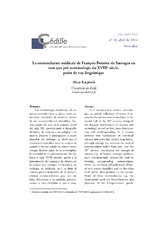Mostrar el registro sencillo del ítem
La nomenclature médicale de François Boissier de Sauvages en tant que pré-terminologie du XVIIIe siècle: point de vue linguistique
| dc.contributor.author | Kacprzak, Alicja | |
| dc.date.accessioned | 2019-03-11T07:27:38Z | |
| dc.date.available | 2019-03-11T07:27:38Z | |
| dc.date.issued | 2014 | |
| dc.identifier.issn | 1699-4949 | |
| dc.identifier.uri | http://hdl.handle.net/10396/18080 | |
| dc.description.abstract | Las terminologías modernas, tal como se entienden hoy, es decir, como colecciones ordenadas de términos dentro de sus correspondientes disciplinas, fueron creadas tan solo en la segunda mitad del siglo XX, aprovechando el desarrollo dinámico de ciencias y tecnologías y su masiva difusión y propagación a escala mundial. Sin embargo, es obvio que el vocabulario específico para los campos de ciencia o técnica existía ya mucho antes, aunque durante siglos no se contemplase la necesidad de su sistematización. No fue hasta el siglo XVIII cuando, gracias a la introducción del concepto de sistema en la ciencia (por ejemplo, en botánica, en zoología, en medicina, etc.), se abrió el camino para la formación de las nomenclaturas correspondientes que, por un lado, denominan a las unidades pertenecientes a cada disciplina y, por el otro, definen su posición en el sistema. Muchas de estas nomenclaturas, como sin ir más lejos la monumental obra del año 1771 del botánico y medico francés de la época del Siglo de la Luces, Francois Boissier de Sauvages, titulada La nosologie methodique […], no solo fueron revolucionarias para su tiempo, sino que siguen manteniendo su importancia hoy en día. Nuestro articulo evoca las hipótesis de este erudito a la hora de crear la tipología de las enfermedades, se concentra por consiguiente en la dimensión lingüística de la clasificación propuesta y recuerda su indudable influencia en la terminología medica contemporánea. | es_ES |
| dc.description.abstract | It is accepted that modern technologies, as orderly collections of terms of respective disciplines, were formed just in the second half of the 20th century, alongside the dynamic development of sciences and technology, as well as their mass dissemination and world-spreading. It is evident however that vocabularies of individual sciences and crafts had existed long before, although through the centuries the need of systematization hadn’t been seen. Just the 18th century, introducing the concept of systems (e.g. in botany, zoology, medicine etc.), simultaneously opened the road to forming corresponding nomenclatures which, on one hand call individuals affiliated to a certain discipline, and on the other hand define their position in the system. Many of those nomenclatures, e.g. the monumental work of a French botanist and physician of the Enlightenment epoch, Francois Boissier de Sauvages, entitled La nosologie methodique […] from year 1771, revolutionary for their times, have saved their meaning until nowadays. Our article, reminding of presumptions took by the author for his typology of diseases, focuses afterwards on the linguistic dimension of the proposed classification and reminds of its undisputed impact on the modern medical nomenclature. | es_ES |
| dc.format.mimetype | application/pdf | es_ES |
| dc.language.iso | fra | es_ES |
| dc.publisher | UCOPress | es_ES |
| dc.rights | https://creativecommons.org/licenses/by/4.0/ | es_ES |
| dc.source | Çedille 10, 193-205 (2014) | es_ES |
| dc.subject | Nosología | es_ES |
| dc.subject | Terminología | es_ES |
| dc.subject | Lenguaje médico | es_ES |
| dc.subject | Nomenclatura | es_ES |
| dc.subject | Término | es_ES |
| dc.subject | Nosology | es_ES |
| dc.subject | Terminology | es_ES |
| dc.subject | Medical vocabulary | es_ES |
| dc.subject | Nomenclature | es_ES |
| dc.subject | Term | es_ES |
| dc.title | La nomenclature médicale de François Boissier de Sauvages en tant que pré-terminologie du XVIIIe siècle: point de vue linguistique | es_ES |
| dc.type | info:eu-repo/semantics/article | es_ES |
| dc.relation.publisherversion | http://www.uco.es/ucopress/ojs/index.php/ced | es_ES |
| dc.rights.accessRights | info:eu-repo/semantics/openAccess | es_ES |

